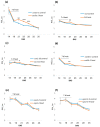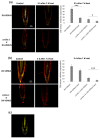CSN5A Subunit of COP9 Signalosome Temporally Buffers Response to Heat in Arabidopsis
- PMID: 31795414
- PMCID: PMC6995552
- DOI: 10.3390/biom9120805
CSN5A Subunit of COP9 Signalosome Temporally Buffers Response to Heat in Arabidopsis
Abstract
The COP9 (constitutive photomorphogenesis 9) signalosome (CSN) is an evolutionarily conserved protein complex which regulates various growth and developmental processes. However, the role of CSN during environmental stress is largely unknown. Using Arabidopsis as model organism, we used CSN hypomorphic mutants to study the role of the CSN in plant responses to environmental stress and found that heat stress specifically enhanced the growth of csn5a-1 but not the growth of other hypomorphic photomorphogenesis mutants tested. Following heat stress, csn5a-1 exhibits an increase in cell size, ploidy, photosynthetic activity, and number of lateral roots and an upregulation of genes connected to the auxin response. Immunoblot analysis revealed an increase in deneddylation of CUL1 but not CUL3 following heat stress in csn5a-1, implicating improved CUL1 activity as a basis for the improved growth of csn5a-1 following heat stress. Studies using DR5::N7-VENUS and DII-VENUS reporter constructs confirm that the heat-induced growth is due to an increase in auxin signaling. Our results indicate that CSN5A has a specific role in deneddylation of CUL1 and that CSN5A is required for the recovery of AUX/IAA repressor levels following recurrent heat stress to regulate auxin homeostasis in Arabidopsis.
Keywords: COP9 signalosome; VENUS reporter construct; auxin signaling; cullin deneddylation; hypomorphic mutants.
Conflict of interest statement
There is no conflict of interest.
Figures







References
Publication types
MeSH terms
Substances
LinkOut - more resources
Full Text Sources
Molecular Biology Databases

